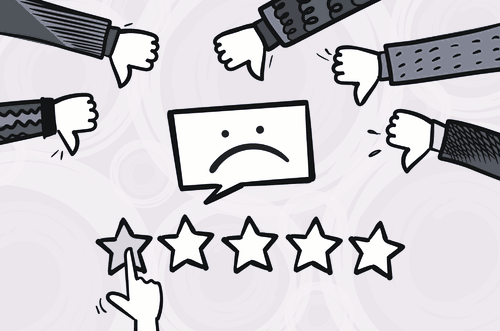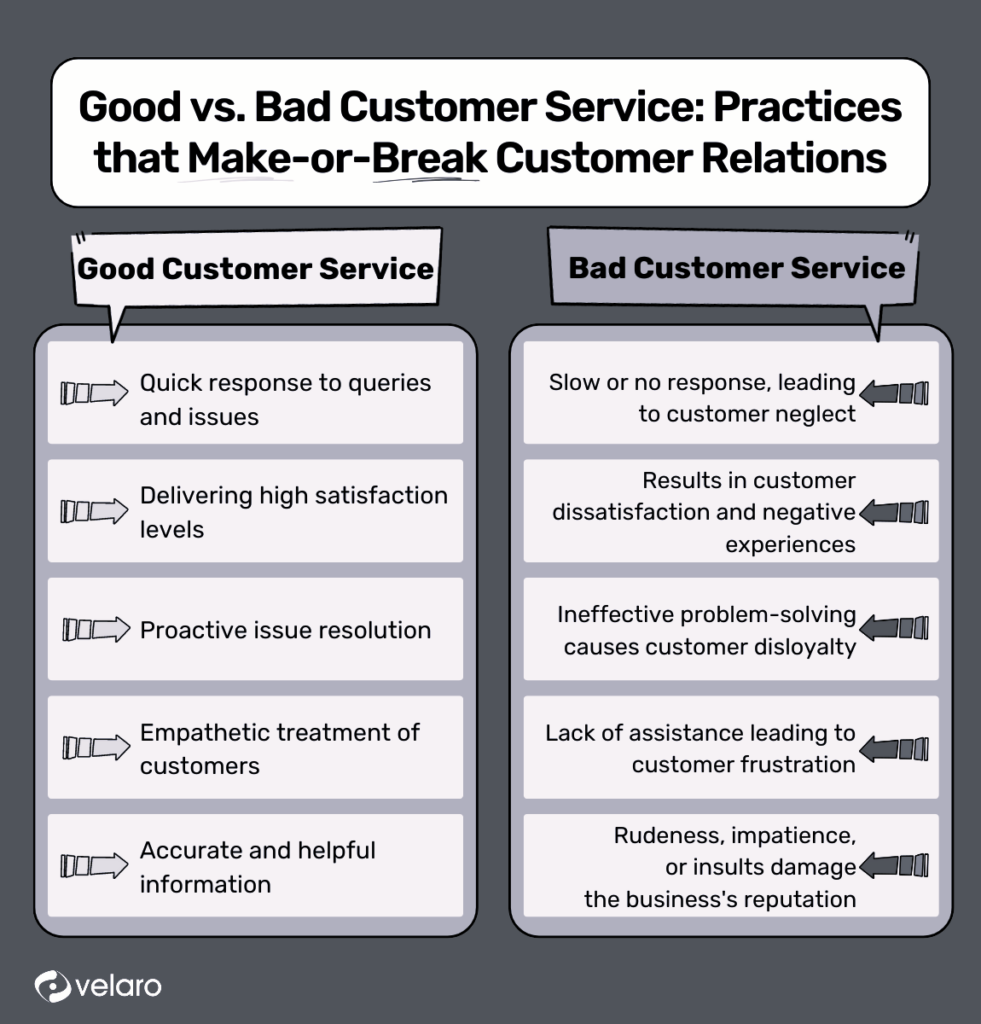In the competitive world of business, poor customer service examples can make or break your company’s reputation. Poor customer service not only drives customers away but can also tarnish your brand’s image.
According to a recent study, 58% of consumers will never use a company again after a single negative experience.
By examining these poor customer service examples, businesses can gain valuable insights into the areas where they might be falling short. We will explore actual situations that showcase how customer service can fail due to slow response times and ineffective problem solving, as well as ways to enhance it. Recognizing typical mistakes in customer service and knowing how to steer clear of them is essential for any business aiming for greatness. In this blog post, we will examine six instances of subpar customer service and offer practical advice on avoiding these errors.
6 Examples of Bad Customer Service
1. Poor Communication
Example: Case Study of Miscommunication
Poor communication is a frequent problem in customer service. Picture a scenario where a client reaches out to a customer service team regarding a mistake in the billing process, only to receive a unclear and ambiguous reply. The absence of effective communication can result in misunderstanding, annoyance, and in the end, dissatisfaction among customers. One example is when a large telecommunications company received negative feedback due to their customer service team giving contradictory information about service disruptions, causing frustration and anger among customers.
How to Avoid It
- Implement Clear Communication Protocols: Establish clear communication protocols to outline how information should be communicated to customers. Make sure that all team members follow these standards.
- Train Staff on Effective Communication Skills: Provide your team with training to improve their communication skills, focusing on clarity and empathy.
- Use Customer Feedback: Consistently analyze feedback to pinpoint and address communication gaps.
2. Lack of Follow-Up
Example: Case Study of Ignored Complaints
A common problem that occurs often is the absence of proper follow-up. Imagine a situation in which a customer reports a faulty product, but the company neglects to address the issue. This mistake may lead to lingering problems and a feeling of being ignored. An instance where an e-commerce platform received criticism due to unaddressed complaints about faulty products from dissatisfied customers.
How to Avoid It
- Establish Follow-Up Procedures: Develop a plan to guarantee that all customer engagements are promptly followed up on.
- Use CRM Systems: Introduce a CRM system for monitoring customer engagements and organizing future communication.
- Ensure Timely Responses: Make sure to respond quickly by setting up notifications for unresolved problems and prioritizing timely replies.
3. Inadequate Training
Example: Case Study of Untrained Staff
Insufficient training can have a significant effect on the quality of service provided. Picture a customer service agent lacking the required expertise to solve a technical problem. The absence of knowledge may result in the provision of inaccurate information. For example, a software company saw an increase in customer complaints because its support staff, who were not properly trained, struggled to manage technical inquiries efficiently.
How to Avoid It
- Invest in complete training programs: Create detailed training resources and hold frequent training sessions.
- Update training resources: Ensure training materials are current with the most recent information and top practices.
- Promote Ongoing Education: Cultivate an environment of learning and growth to maintain the sharpness of your team’s abilities.
4. Over-Promising and Under-Delivering
Example: Case Study of Broken Promises
Making promises that are beyond your capabilities and failing to meet expectations can damage the confidence that customers have in your business. If a company guarantees fast delivery but doesn’t meet the deadline, customers may be let down. An online retail business received criticism for promising next-day delivery but failing to meet deadlines often, resulting in unhappy customers.
How to Avoid It
- Set Realistic Expectations: Make sure that any commitments to customers can be met and are feasible.
- Communicate Changes Promptly: Notify customers promptly of any delays or problems, and give them updates accordingly.
- Honor Commitments: Ensure that you follow through on the agreements you make with clients.
5. Lack of Personalization
Example: Case Study of Generic Service
Not personalizing experiences can lead customers to feel unappreciated. For instance, if a customer service agent follows a generic script without taking into account the customer’s individual needs, it can result in a negative encounter. A large retailer faced backlash for its uniform way of interacting with customers, resulting in lower customer satisfaction levels.
How to Avoid It
- Use Customer Data: Use customer data to customize interactions and deals based on individual preferences.
- Train Staff for Personalization: Train your employees to personalize services by helping them develop the ability to identify and cater to individual customer requirements.
- Implement Personalization Technologies: Employ tools that enable customized service according to customer’s past interactions and preferences.
6. Ignoring Feedback
Example: Case Study of Unacknowledged Feedback
Failing to take into account customer feedback could result in overlooking chances for enhancement. If customers report a negative experience but the company takes no action to resolve the issues, it can result in ongoing dissatisfaction. A popular restaurant franchise received backlash for neglecting customer input on menu alterations, resulting in reduced customer loyalty.
How to Avoid It
- Actively Solicit Feedback: Consistently request input via surveys, reviews, and direct conversations.
- Implement Changes Based on Feedback: Utilize feedback to guide decisions and enhance your service by implementing changes accordingly.
- Communicate Actions Taken: Inform customers about implemented changes in response to their feedback to ensure transparency and communication of actions taken.
Consequences of Poor Customer Service
Poor customer service can have severe repercussions for any business, leading to lost revenue, damaged reputation, and customer churn. The impact of poor customer service is often underestimated, but it can be catastrophic, affecting a company’s bottom line and long-term viability. There are numerous poor customer service examples that highlight these negative outcomes.
One of the most immediate consequences of poor customer service is lost revenue. When customers have a negative experience, they are less likely to make repeat purchases. This switch not only results in lost sales but also increases customer acquisition costs as businesses need to spend more on marketing to attract new customers.
Additionally, unhappy customers tend to spend less during their remaining interactions with the company, further reducing potential revenue. Many poor customer service examples illustrate how a single bad interaction can lead to significant revenue losses.A damaged reputation is another critical consequence of poor customer service.
According to research, it takes 40 positive customer experiences to undo the damage of a single negative review. This demonstrates how a few instances of poor service can overshadow a multitude of positive interactions and long-term efforts to build a good reputation. Poor customer service examples often highlight how quickly and widely negative experiences can be shared, causing lasting damage to a brand’s reputation.
How to Avoid Bad Customer Service
To provide top-notch customer service, businesses need to focus on several key areas. First and foremost, hiring the right people is crucial. Support representatives should possess the necessary communication skills and expertise to handle customer inquiries effectively. This means looking for individuals who are not only knowledgeable but also empathetic and patient.
Monitoring quality is another essential component of excellent customer service. Implementing continuous quality assurance processes helps maintain high service standards. Regularly reviewing customer interactions and providing feedback to support representatives can help identify areas for improvement and ensure that any deviations from established protocols are corrected promptly.
Ongoing training is vital for keeping support representatives’ skills sharp and up-to-date. Regular training sessions should be conducted to introduce new techniques, tools, and best practices. This not only helps in improving the quality of service but also keeps the team motivated and engaged.
The Role of Technology in Enhancing Customer Service
Incorporating technology can significantly improve the efficiency and effectiveness of customer service operations. One of the most impactful technologies is AI-powered chatbots. These chatbots can handle routine inquiries and provide instant responses, freeing up human agents to deal with more complex issues.
Automated follow-ups are another technological advancement that can benefit customer service. Automation tools can be used to schedule follow-ups, ensuring that no customer inquiry goes unattended. This not only helps in maintaining consistent communication with customers but also reduces the likelihood of complaints being forgotten or ignored.
Data analytics plays a crucial role in personalizing customer service. By leveraging data analytics, businesses can gain valuable insights into customer behavior and preferences. This information can be used to tailor interactions and offers to individual customers, making them feel valued and understood.
Let us now introduce the best customer service outsourcing agency-
Helplama: Best Customer Service Outsourcing Agency
Helplama is recognized as one of the top choices for outsourcing customer service in the industry. They provide customized customer service solutions that cater to the specific requirements of individual clients.
Why Choose Helplama?
- Expertise: Helplama has a team of customer service experts with years of experience.
- Customization: Tailored solutions are offered to meet the specific requirements of your business.
- Technology: Using the most up-to-date technology to improve the effectiveness of customer service.
Services Offered:
- Live Chat Support: Real-time assistance for your customers.
- Email Helpdesk: Efficient handling of customer queries via email.
- Social Media Integration: Managing customer interactions on social media platforms.
Opting for Helplama guarantees competent handling of your customer service, freeing you up to concentrate on other vital areas of your business.
Conclusion
Understanding and addressing common mistakes in customer service is essential for any business looking to improve its customer relations and maintain a positive reputation. Poor customer service can have significant consequences, including lost revenue, damaged brand reputation, and high customer churn rates.
For instance, research indicates that 52% of customers switch to competitors after a single bad experience, and 91% of dissatisfied customers do not return.
By learning from poor customer service examples and implementing best practices, businesses can enhance their customer service operations and ensure a better experience for their clients. One way to achieve this is by thoroughly analyzing common pitfalls, such as poor communication, lack of follow-up, inadequate training, over-promising and under-delivering, lack of personalization, and ignoring feedback.






